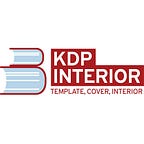Guide For KDP Book Size Template Print Formatting
Amazon Kindle Direct Publishing (Amazon KDP) is a fast and easy way for authors and publishers to keep control and publish their books worldwide on the Kindle platform. KDP has removed the barriers for people wanting to self-publish by allowing authors to get their books in Kindle stores worldwide.
Many authors have completely ignored physical books since the 2012 Kindle gold rush, concentrating primarily on digital eBook sales. As a result, print books were perceived as unimportant, and people predicted their sales would eventually decline.
But that didn’t happen and probably won’t happen, either. Even if sales of digital books have skyrocketed, traditional books are still hugely popular. In light of this, many prospective customers are lost by authors who overlook print.
Guide For KDP Book Size Template Print Formatting
Self-publishing a print book used to be expensive and dangerous. As a result, many authors (and publishers) were left with enormous stacks of unsold books in which they had made significant financial investments.
However, thanks to POD (print-on-demand) technology, books are printed when customers purchase (and pay for) them. The cover design and formatting are the only expenses for the author/publisher. Print-on-demand is a fantastic development for authors, enabling you to capitalize on the sizable print book market while spending as little money as possible.
Print books can now be self-published through various channels, including IngramSpark and Amazon’s KDP Print on Demand platform. The most user-friendly for independent authors is KDP book size template Print, Amazon’s well-established print-on-demand division (it used to be called CreateSpace, but Amazon shut down CreateSpace in 2018 and moved all their printing services over to KDP).
How to Measure Your KDP book size template for Printing
Over six million copies of books, cards, games, and other items have been printed by PrintNinja since the company’s first project was completed in 2009. We’ve seen everything, from tabbed catalog pages to book covers that serve as drink coasters. One of the most often requested issues we receive during the prepress stage is how to measure your book correctly. Understanding the precise measurements of your book is essential if you want it to come out precisely as you had envisioned it, regardless of the type of project you are publishing.
All you need to determine your book’s size is:
- Book \Ruler
- robust flat item (such as a book or piece of cardboard)
- Flat ground
The dimension parallel to the spine, known as height, is the first to be considered. Hold the cardboard against your book at the bottom of the spine while placing it on a flat surface. Next, measure from the cardboard with your ruler to the top of the book, considering the ruler’s extra length at the end. The breadth, which is the dimension perpendicular to the spine, should be measured similarly. The pictures show these processes to the nearest 1/8 of an inch measure.
When printing a hardcover book, the cover sticks out on both sides by about 1/8" from the pages inside. Plan accordingly because a hardcover book that is 6" x 9" will be closer to 6.25" x 9.25".
Commonly Book Sizes
- 6.625" x 10.25" for a comic book
- 8.5" x 11" for magazines or catalogs
- Book for children: 8.5" x 11" or 11" x 8.5"
- Paperback Novel: 6" x 9" or 5.5" x 8.5"
- 6" x 9" Hardcover Novel
- 8.5" x 11" for booklets
- 8.5" x 11" or 9" x 12" for an art book.
- 8.5" x 11" or 9" x 12" photo book
Visit our industry-standard pages for a more thorough overview of typical book sizes, materials, and bindings.
How Do You Determine The Size Of a Book?
Measure from the cardboard with your ruler to the top of the book, considering the ruler’s extra length at the end. The breadth, which is the dimension perpendicular to the spine, should be measured similarly.
There are a few factors to consider when determining the size of a book. The first is the dimensions of the book itself. The width and height of the book will determine how many pages it can fit. The second is the type of paper the book is printed on.
The thinner paper will allow for more pages, while thicker paper will result in fewer pages. The third factor is the font size. A smaller font will allow for more text on each page, while a larger font will take up more space. Finally, the margin size will also affect the number of pages in a book. A smaller margin will allow for more text on each page, while a more considerable margin will result in fewer pages.
Final Think
It is not easy to determine how big a book is, but there are some clues. The most obvious one is the page count. The page count is usually printed on the lower corner of the book’s first page. You can also look at the dimensions of the paper to determine its size. Usually, the dimensions of the article are printed on the back of the title page. The dimensions are given in inches and are generally accompanied by the printer’s name.
